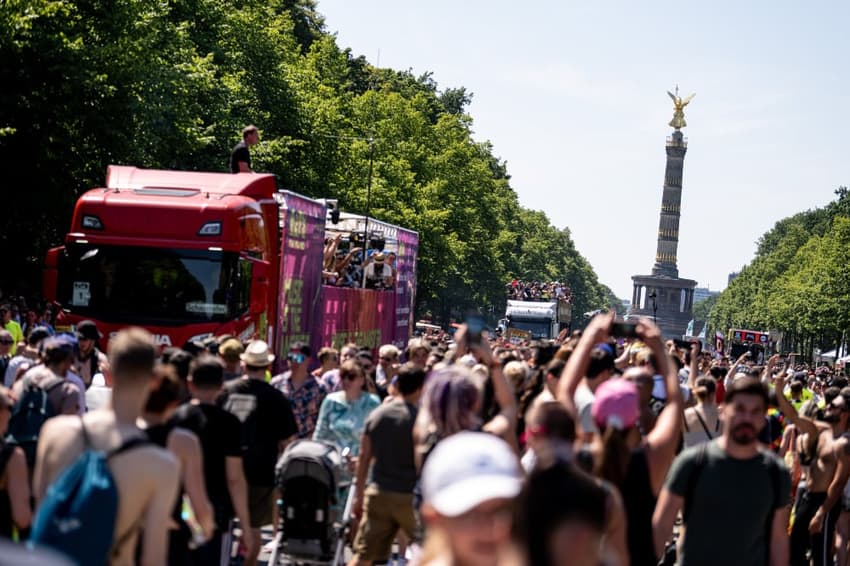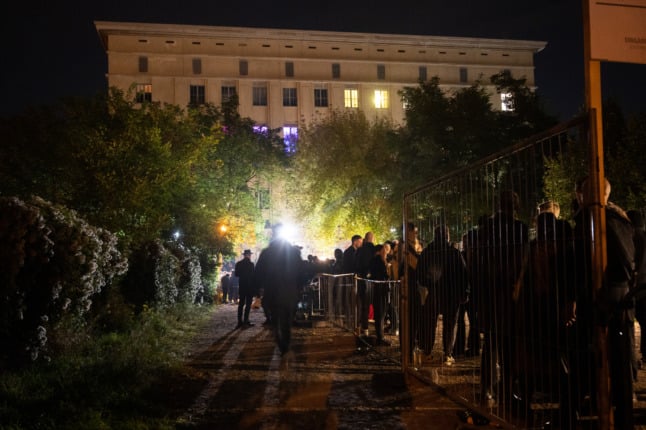Berlin's techno scene added to UNESCO World Heritage list

Long a token aspect of culture in the capital city, Berlin's techno scene is one of six new entries on an ‘UNESCO list of intangible cultural heritage in Germany.
The decision was made this week at the Conference of Culture Ministers of Germany’s 16 states together with Culture Minister Claudia Roth.
The other new cultural gems on the list are mountaineering in Saxony, the 'Finsterwalder' singing tradition in Brandenburg, the ‘Kirchseeon Perchtenlauf’ New Year's day tradition in Bavaria, 'Schwälmer' white embroidery from Hesse, and 'Viez', the winemaking from apples, pears or quinces in the Moselle-Franconian region.
There are now 150 entries in the list, which show the diversity of cultural life in Germany.
READ ALSO: 10 must-see UNESCO World Heritage sites in Germany
Why Berlin techno made the cut
Roth praised the new entries as an important sign of an expanded concept of culture that opposes "the absurd separation" of serious and entertainment culture.
The inclusion of Berlin's techno culture is indicative of this, she said.
"Whether subculture or traditional craftsmanship, all of this is part of the cultural wealth of our country," Roth said in a press release about the decision.
"The latest entries underline the diversity and vitality of cultural practices," said Timon Gremmels (SPD), Chair of the Conference of Culture Ministers.
"The list of our intangible heritage thus continues to grow, as does our commitment to cultivating traditions and preserving them for future generations in the long term,” he added.
Over the course of the 1980s, the Berlin club scene developed into one of the world's leading centres of the beloved techno subculture of the time.
The electronic music genre in particular became a kind of soundtrack to the years following German reunification, symbolised by legendary clubs such as Tresor, which opened in 1991, and the annual Love Parade.
The German Commission for Unesco defines techno as music "characterised by electronic sounds that are strung together in a rhythmically monotonous structure. It is characterised by the very high modulability and bandwidth of frequencies. DJs lead from one track to the next through synchronised transitions, the so-called 'mix'."
READ ALSO: Berlin clubs - the ten most famous and notorious

Hundreds of people queue outside Berghain, Berlin's most famous techno club, on October 2nd, 2021. Photo: picture alliance/dpa | Christophe Gateau
From niche to subsidised
The push to include techno culture on the UNESCO list was driven by the non-profit limited company Rave the Planet, whose management includes Love Parade co-initiator Matthias Roeingh, aka Dr Motte. To support the initiative, Rave the Planet had already organised techno parades in Berlin in 2022 and 2023.
The techno scene hopes that its status as part of the intangible cultural heritage will bring social and legal benefits. According to the website of Dr Motte's initiative, it will promote awareness that techno has long since stepped out of its niche and become a cultural form in its own right.
In addition, hurdles and requirements for the opening and maintenance of clubs could be lowered. It is also hoped that access to state subsidies and charitable funding will become easier for club, who became especially cash-strapped during the Covid-19 pandemic.
What are the other new traditions on the list?
When it comes to mountaineering in Saxony, the commission refers specifically to the mountain huts and 'Boofen', open-air overnight shelters that are traditionally used by climbers. The 'Boofen' is about "a holistic experience that enables social interaction in the context of a respectful and restrained approach to nature".
According to the German UNESCO Commission, the 'Finsterwalde' singing tradition developed from a three- to four-part a cappella song, the 1899 couplet by composer Wilhelm Wolff "Wir sind die Sänger von Finsterwalde" (We are the singers of Finsterwalde). In the small town in eastern Brandenburg, this is an identity-forming singing tradition that choirs and music groups are constantly developing.
The 'Kirchseeon Perchtenlauf' is held in the Upper Bavarian market town of Kirchseeon, where the Perchten - scary, beautifully masked frightening figures - parade around to ring in the New Year. Kirchseeon Perchten are considered to bring good luck, symbolically banishing the spirits of darkness with their rituals and awakening the spirits of new beginnings.
'Schwalm' white embroidery is a traditional craft technique that is practised in the Schwalm region of Hesse and beyond. Various motifs are embroidered with white thread on tightly woven linen.
Lastly, 'Viez' is a wine made from cultivated apple, pear and quince varieties. According to the UNESCO Commission's description, the cultivation strengthens biodiversity and characterises the image of the cultural landscape in the Moselle-Franconian language region.
READ ALSO: 5 things you really should know about wine in Germany
Comments
See Also
The decision was made this week at the Conference of Culture Ministers of Germany’s 16 states together with Culture Minister Claudia Roth.
The other new cultural gems on the list are mountaineering in Saxony, the 'Finsterwalder' singing tradition in Brandenburg, the ‘Kirchseeon Perchtenlauf’ New Year's day tradition in Bavaria, 'Schwälmer' white embroidery from Hesse, and 'Viez', the winemaking from apples, pears or quinces in the Moselle-Franconian region.
There are now 150 entries in the list, which show the diversity of cultural life in Germany.
READ ALSO: 10 must-see UNESCO World Heritage sites in Germany
Why Berlin techno made the cut
Roth praised the new entries as an important sign of an expanded concept of culture that opposes "the absurd separation" of serious and entertainment culture.
The inclusion of Berlin's techno culture is indicative of this, she said.
"Whether subculture or traditional craftsmanship, all of this is part of the cultural wealth of our country," Roth said in a press release about the decision.
"The latest entries underline the diversity and vitality of cultural practices," said Timon Gremmels (SPD), Chair of the Conference of Culture Ministers.
"The list of our intangible heritage thus continues to grow, as does our commitment to cultivating traditions and preserving them for future generations in the long term,” he added.
Over the course of the 1980s, the Berlin club scene developed into one of the world's leading centres of the beloved techno subculture of the time.
The electronic music genre in particular became a kind of soundtrack to the years following German reunification, symbolised by legendary clubs such as Tresor, which opened in 1991, and the annual Love Parade.
The German Commission for Unesco defines techno as music "characterised by electronic sounds that are strung together in a rhythmically monotonous structure. It is characterised by the very high modulability and bandwidth of frequencies. DJs lead from one track to the next through synchronised transitions, the so-called 'mix'."
READ ALSO: Berlin clubs - the ten most famous and notorious

From niche to subsidised
The push to include techno culture on the UNESCO list was driven by the non-profit limited company Rave the Planet, whose management includes Love Parade co-initiator Matthias Roeingh, aka Dr Motte. To support the initiative, Rave the Planet had already organised techno parades in Berlin in 2022 and 2023.
The techno scene hopes that its status as part of the intangible cultural heritage will bring social and legal benefits. According to the website of Dr Motte's initiative, it will promote awareness that techno has long since stepped out of its niche and become a cultural form in its own right.
In addition, hurdles and requirements for the opening and maintenance of clubs could be lowered. It is also hoped that access to state subsidies and charitable funding will become easier for club, who became especially cash-strapped during the Covid-19 pandemic.
What are the other new traditions on the list?
When it comes to mountaineering in Saxony, the commission refers specifically to the mountain huts and 'Boofen', open-air overnight shelters that are traditionally used by climbers. The 'Boofen' is about "a holistic experience that enables social interaction in the context of a respectful and restrained approach to nature".
According to the German UNESCO Commission, the 'Finsterwalde' singing tradition developed from a three- to four-part a cappella song, the 1899 couplet by composer Wilhelm Wolff "Wir sind die Sänger von Finsterwalde" (We are the singers of Finsterwalde). In the small town in eastern Brandenburg, this is an identity-forming singing tradition that choirs and music groups are constantly developing.
The 'Kirchseeon Perchtenlauf' is held in the Upper Bavarian market town of Kirchseeon, where the Perchten - scary, beautifully masked frightening figures - parade around to ring in the New Year. Kirchseeon Perchten are considered to bring good luck, symbolically banishing the spirits of darkness with their rituals and awakening the spirits of new beginnings.
'Schwalm' white embroidery is a traditional craft technique that is practised in the Schwalm region of Hesse and beyond. Various motifs are embroidered with white thread on tightly woven linen.
Lastly, 'Viez' is a wine made from cultivated apple, pear and quince varieties. According to the UNESCO Commission's description, the cultivation strengthens biodiversity and characterises the image of the cultural landscape in the Moselle-Franconian language region.
READ ALSO: 5 things you really should know about wine in Germany
Join the conversation in our comments section below. Share your own views and experience and if you have a question or suggestion for our journalists then email us at [email protected].
Please keep comments civil, constructive and on topic – and make sure to read our terms of use before getting involved.
Please log in here to leave a comment.